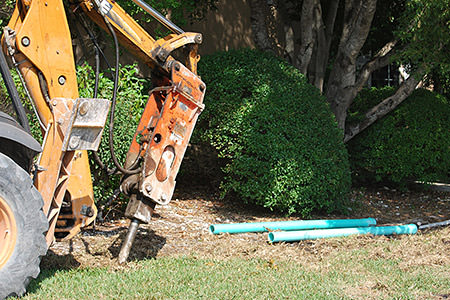Water Quality
Florida Keys

Why is it a concern?
Water quality is a key element that unites all sanctuary resources and is essential to maintaining the richness and diversity of its varied environments. Some stressors affecting water quality in the Florida Keys National Marine Sanctuary are being ameliorated as a result of actions recommended by its Water Quality Protection Program, but the predicted effects of global climate change are likely to exacerbate conditions via changes in storm frequency and intensity, changing variability of seawater temperature, sea level rise, and other changes to oceanographic patterns and ocean chemistry.
Domestic wastewater from illegal cesspits and outdated septic systems has been contributing to nonpoint source pollution in the Florida Keys since the 1940’s, but improvements being made in wastewater treatment and decommissioning the septic systems and cesspits is expected to significantly reduce wastewater impacts in the area. Similarly, bacteria and nutrients from boat sewage has been reduced by state and federal laws regulating operation of marine sanitation devices, the sanctuary-wide prohibition of discharge of sewage incidental to vessel use and generated by a marine sanitation devices (established in 2010), and the readily available ‘pump-out’ facilities throughout the area. Storm water runoff is another nonpoint source of nutrients and contaminants in the Florida Keys and there are efforts underway to begin addressing that. Water contamination from activities associated with marinas and boating also impact water quality, and include toxic metals from anti-fouling paints, hydrocarbons from motor operations and maintenance, and overboard solid waste disposal (e.g., cardboard frozen bait containers). Sanctuary waters are also vulnerable to insecticide runoff and unintentional over spraying in efforts to control mosquito populations in the Florida Keys and associated pathogens like West Nile virus, Dengue fever, and viral encephalitis. The effects of insecticides on non-target organisms (e.g., Queen conch (Strombus gigas)), remains relatively unknown.
Overview of Research
Research conducted by Sanctuary scientists and partners provides critical information to address existing and emerging resource conservation and management issues. The Overview of Research highlights some, but not necessarily all, of the research activities completed or ongoing at the Sanctuary.
| Project Name | PI and contacts | Links |
|---|---|---|
Water Quality Monitoring Program |
||
Coral Reef Evaluation and Monitoring Program |
||
Seagress Monitoring Program |
||
Data Buoy, MAPCO2 |
Science Needs and Questions
The best available science is used by Sanctuary scientists and managers working to address priority resource conservation and management issues. As priorities change and new issues emerge, each Sanctuary develops new science needs and questions and works with partners to address them.
- What are the nutrient loadings from Florida Bay and the Gulf of Mexico into waters surrounding the Florida Keys?
- What are the impacts of episodic events, such as rainfalls, major storms, and upwellings, on water quality parameters upstream and within the Sanctuary?
- How does nutrient load flux in the water column during upwelling events, particularly at the reef tract?
- What is the organic and nutrient loading contribution of decomposing seagrass and algae wrack that accumulates along shorelines and in canals and other confined water bodies, in near shore waters?
- Where are injection wells and arrays of wells not functioning properly and acting as sources of pollution to local ground water?
- What are the geochemical changes in wastewater injected into disposal wells as it passes through limestone, and are these changes detrimental to local water quality?
- What are the effects of pest control sprays (e.g., mosquito control) on non-target organisms?
- Can a nutrient loading model be developed for the FKNMS ecosystem using existing research and data?
Education and Outreach Material
Please refer to the Florida Keys National Marine Sanctuary website to learn more about education and outreach materials.
References
Office of National Marine Sanctuaries. 2011. Florida Keys National Marine Sanctuary Condition Report 2011. U.S. Department of Com-merce, National Oceanic and Atmospheric Administration, Office of National Marine Sanctuaries, Silver Spring, MD. 105 pp.
Glazer, R., N. Denslow., N. Brown-Peterson, P. McClellan-Green, D. Barber, N. Szabo, G. Delgado, K. Kroll, I. Knoebl, D. Spade. 2008. Anthropogenic effects on queen conch reproductive development in South Florida, a final report. Florida Fish and Wildlife Conservation Com-mission, Fish and Wildlife Research Institute. 73pp. Electronic document available from: http://ocean.floridamarine.org/the sanctuary_wqpp/products/special_projects/2009/glazer_denslow.pdf
Kruczynski, W.L. and F. McManus. 2002. Water quality concerns in the Florida Keys: sources, effects, and solutions. In: Porter JW, Porter KG (eds.) The Everglades, Florida Bay, and coral reefs of the Florida Keys: an ecosystem sourcebook. CRC Press, Boca Raton, pp 827–881.
Leichter, J.L., H.L. Stewart, S.L. Miller. 2003. Episodic nutrient transport to Florida coral reefs. Limnology and Oceanography 48(4):1394-1407.
McIntyre, M., R.A. Glazer, G.A. Delgado. 2006. The effects of the pesticides Biomist 30/30 and Dibrom on queen conch (Strombus gigas) embryos and larvae: a pilot study. Proc. Gulf Caribb. Fish. Inst. 57:731 742.
NOAA (National Oceanic and Atmospheric Administration). 1996. Florida Keys National Marine Sanctuary management plan/environmental impact statement, vol II. U.S. Dept. of Commerce, National Oceanic and Atmospheric Administration, National Ocean Service. Silver Spring, MD. 251pp. Electronic document available from: http://floridakeys.noaa.gov/management/welcome.html
Szmant, A.M. and A. Forrester, A. 1996. Water column and sediment nitrogen and phosphorus distribution patterns in the Florida Keys, USA. Coral Reefs 15:21–41.

